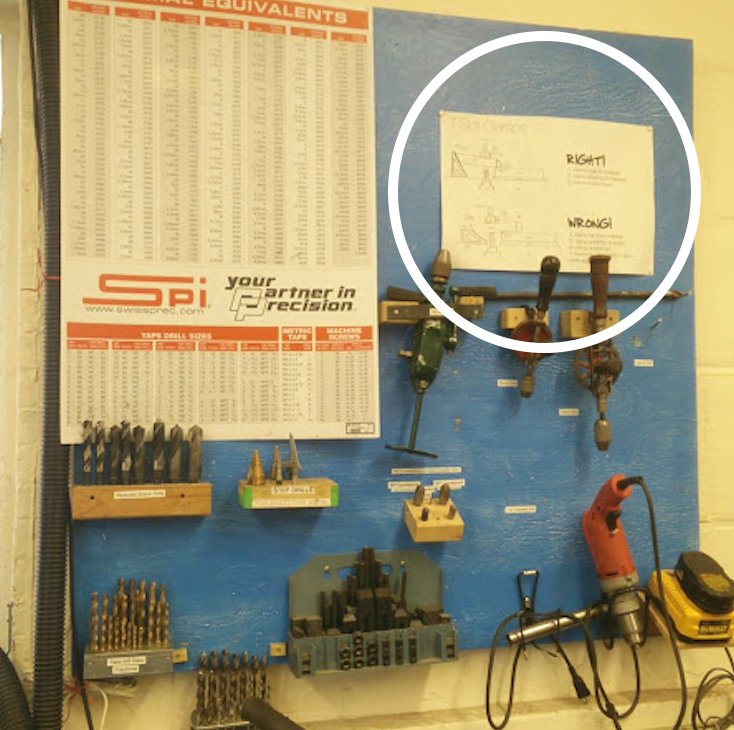
Patina, you (almost) always need more! Patina is physical signage and artifacts made by your stakeholders that comes in two primary forms: Safety and Culture.
Patina, in the form of custom signage and artifacts crafted by makerspace stakeholders, plays a pivotal role in enriching the makerspace environment. This white paper underscores the importance of custom safety and culture signage, highlighting its dual purpose in promoting safety awareness and fostering a sense of ownership among makers. It argues that involving stakeholders in the creation of these signs leads to safer and more vibrant makerspaces.
Custom signage and artifacts, referred to as "patina" in this context, serve as vital components of makerspace environments. They contribute to both safety and culture, playing a crucial role in educating stakeholders about safe tool usage while also imparting a unique character to the space. This white paper delves into the significance of custom patina, focusing on its role in safety and culture enhancement.
Patina: Safety
-

On Tool, Personal Safety
This describes the hazard and the correct operation to avoid physical harm. On Tool is a label affixed directly to a tool.
-

Near Tool, Personal Safety
This often describes the best practices as step-by-step equipment operation from the beginning to the end of a procedure.
-

Near Tool Equipment Operation
These are located near a tool such as this Emergency Stop and the floor arrows.
-

Shop Information
Such as “Please, clean up after yourself,” shop hours, or training sign-up sheets.
Custom Safety Signage
Educational Value: Safety signage is instrumental in teaching makerspace stakeholders how to operate tools and equipment safely and effectively. These signs convey essential information regarding proper usage, potential hazards, and emergency procedures.
Ownership and Awareness: Involve makerspace stakeholders in the creation of custom safety signage whenever possible. This engagement fosters a sense of ownership, making users more aware of the importance of adhering to safety guidelines.
One of the best tools for making signage, and my favorite, is the vinyl cutter. Your makerspace probably has one (if not, put it on your next-to-purchase list). Vinyl cutters are quick and easy to learn and use, allowing you to make adhesive stickers in a wide range of colors and sizes that can be applied to tools or surfaces.
One of the most powerful tools you have to define the safe, welcoming community you are building in your makerspace is through culture patina. Like safety patina, culture patina works best when your makerspace’s stakeholders produce it. Often, this patina manifests as 2D stickers and posters and may also be physical elements for folks working in your space to interact with. The key is your culture patina should always clearly and powerfully call out and define the attitudes, ideals, and principles of your makerspace. Culture patina is vital to welcoming folks who have historically not been included or used a makerspace.
Custom Culture Signage:
Fostering Identity: Custom culture signage reflects the unique identity and values of the makerspace community. These signs can include mission statements, quotes, or symbols that resonate with the ethos of the space.
Community Building: The process of creating culture signage encourages collaboration and creativity among stakeholders, resulting in a shared sense of identity and belonging.
Benefits of Patina:
Safety Promotion: Custom safety signage, crafted by stakeholders, is more likely to be noticed and taken seriously. Makers feel a personal connection to these signs, increasing their commitment to safe practices.
Enhanced Community: Culture signage contributes to a vibrant community within the makerspace. Stakeholders identify with the space's values and are more likely to engage actively in the community.
Authenticity: Patina adds authenticity to the makerspace environment. It distinguishes the space from commercial or industrial settings and reinforces its community-driven nature.
Conclusion:
Custom safety and culture signage, or patina, enriches the makerspace experience in numerous ways. It enhances safety awareness, fosters a sense of community, and imbues the space with authenticity. By involving stakeholders in the creation of these signs, makerspaces can promote safety while strengthening their unique culture and identity.
Incorporating patina into the makerspace environment is not just a matter of aesthetics; it's a strategy for cultivating a vibrant and engaged community of makers who take pride in their space and prioritize safety.
Patina: Culture
-
RISD CoWorks
RISD CoWorks (2019) is one of the first interdisciplinary non-major specific collaborative spaces in the art and design school education space. Even before entering Coworks, stakeholders, the patina signals the social, political, and teaching/learning values inside.
-
Northeastern University’s LGTBQA+ Center
-
The Weissman Foundry
At Northeastern University’s LGTBQA+ Center and the Weissman Foundry, posters, stickers, and artifacts define a welcoming culture of diverse backgrounds, “Tea,” hanging out and making. By blending these four signals into a single station, both Centers say, “We are a diverse, sharing community of makers, and you are welcome here!”.
-
Inviting the Community in
Similarly, large-scale signage, giveaways, and unique marketing campaigns become part of a thoughtfully designed patina to differentiate your makerspace.
Artwork: Julio Le Parc, Continuous light cylinder of the "Enlightenment Series," 1962




